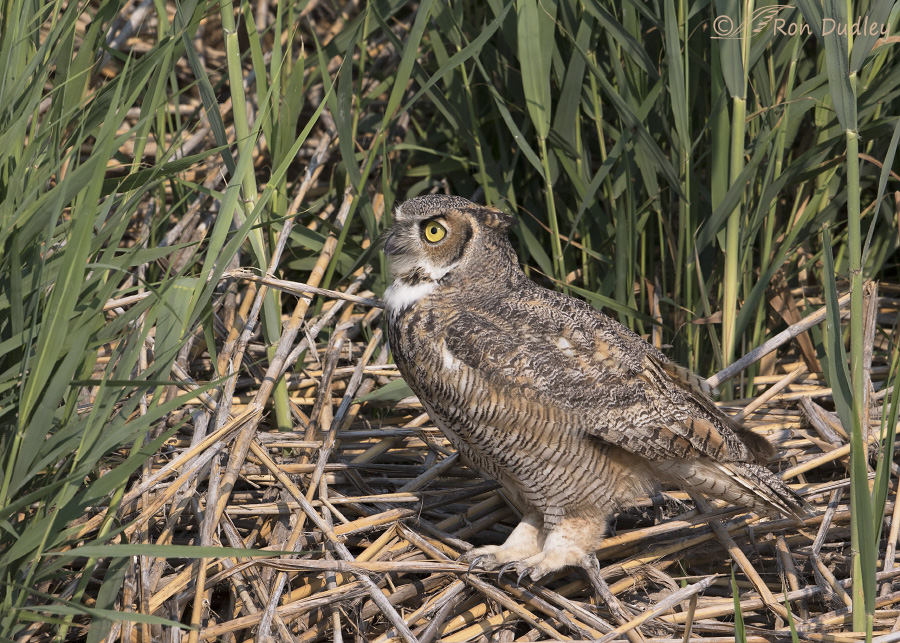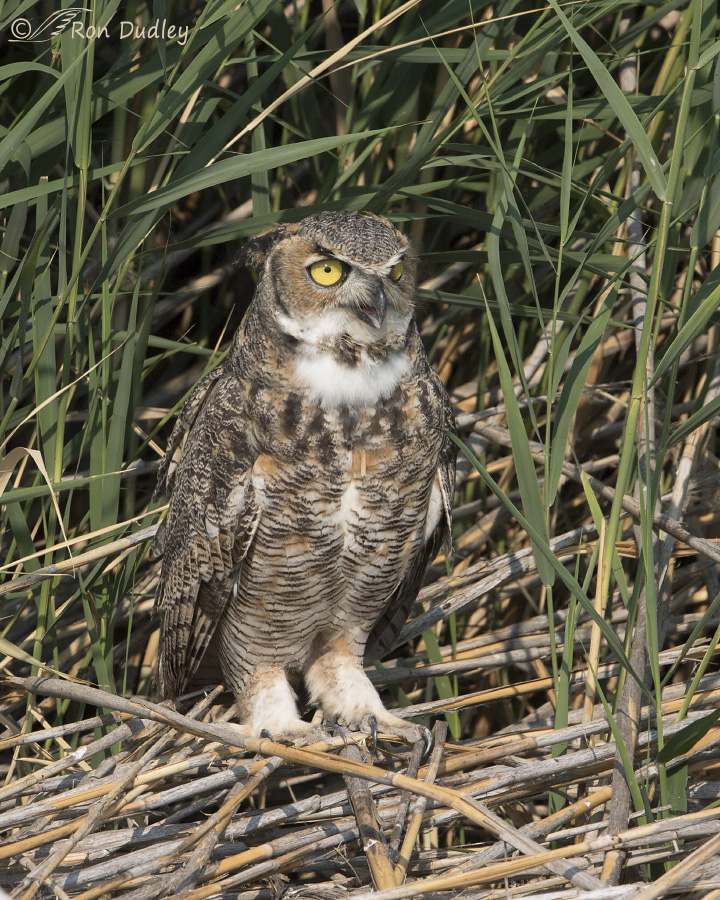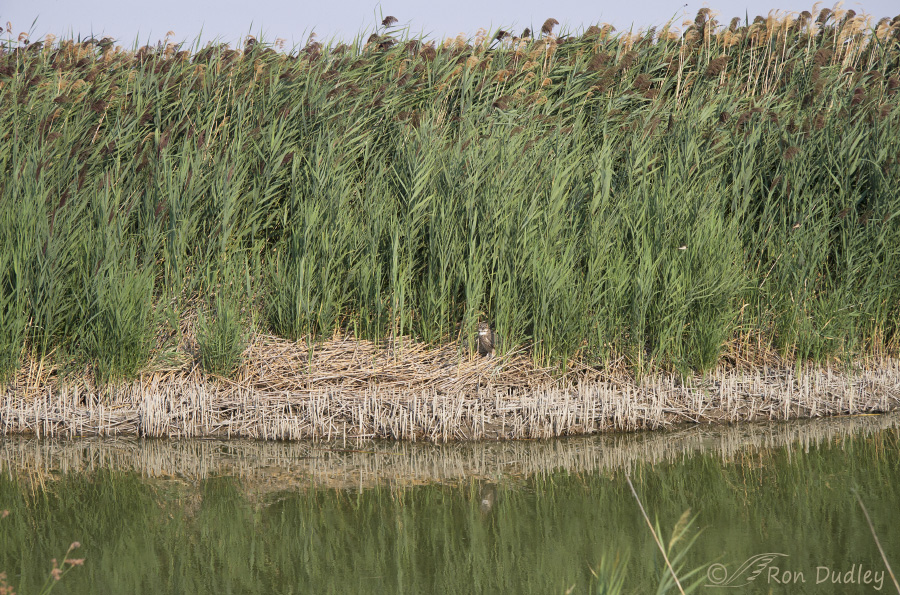This adult Great Horned Owl at Bear River Migratory Bird Refuge yesterday morning surprised me on several levels.

1/2500, f/7.1, ISO 250, Canon 7D Mark II, Canon EF 500mm f/4L IS II USM, not baited, set up or called in
Great Horned Owls are primarily nocturnal perch hunters and in the past when I’ve found this species in the daytime they’ve nearly always been tucked away and sleeping in some shady roost. But this one was mostly out in the open and appeared to be hunting at the base of a thick stand of phragmites along the auto tour route at the refuge. I spent 46 minutes with the bird (beginning at 9:18 AM) and it never did sleep or show any signs of sleepiness.
It would stay in one spot for a while as it appeared to be scanning the dead phrag stems and the nearby water for prey and then it would walk or hop a relatively short distance and do the same thing again.
 1/1000, f/8, ISO 250, Canon 7D Mark II, Canon EF 500mm f/4L IS II USM + 1.4 tc, not baited, set up or called in
1/1000, f/8, ISO 250, Canon 7D Mark II, Canon EF 500mm f/4L IS II USM + 1.4 tc, not baited, set up or called in
One time it flew a hundred yards or so up the canal and then repeated the apparent hunting behavior though I never did see it make an attempt at prey.
I thought it was somewhat unusual that this owl nearly always kept its ear tufts (“horns”) flattened down on its head instead of erect.

1/1250, f/8, ISO 400, Canon 7D, Canon EF-S17-85mm f/4-5.6 IS USM @ 66mm
This photo gives the viewer a better sense of habitat – you can see the owl (and its reflection) slightly below center of the image.
Finding this beautiful owl in such a place was an unexpected treat. I believe this was the first time I’ve photographed a Great Horned Owl in a marshy environment though they’re known to occasionally occupy such habitats.
Ron


What a treat and wonderful surprise. Thank you for sharing!!
WOW!
Wow. Beautiful pictures once again, Ron. And 453 photos of this bird! Since I am very new to photography, what is the capacity of the camera you are using and how long does it take you to find the wonderful shots you share with us?
Elizabeth
Elizabeth, “capacity” of a camera is determined by the size of your memory card and the size of the images taken by your camera. I’m typically using a fast 32 gig card so my capacity is several thousand images (I’ve yet to fill that card up in one shooting session). And I always carry several additional cards with me.
How long it takes me to get the shots varies considerably depending on the birds. I’ve spent 3-4 hours in the field without firing off any shots. On other mornings, especially when I find cooperative birds, I may shoot as many as 1200 – 1500 images in the same amount of time.
I had once heard that a photographer is known not by what he shoots but by what he shows…and your dedication to the task is remarkable, making me think of the advice I used to give to my composition students: write fast and far more than you need. Then you can carve out the clutter and get to the heart of your story or essay. One has to be generous in what is left on the cutting room floor…although I bet many of the images you find unsatisfactory would please others very much. Thank you for giving me a glimpse into your work ethic.
My experience with raptors is that there is no absolute ‘normal’…. most would say, for example that a Red Tail would never feed
on roadkill, yet one time I saw a Red Tail feeding on roadkill, thus, with this GHOW, while unusual behaviour to be hunting on the ground and
during daylight hours….there you have it! They are always good at keeping
us on our toes, eh?!
The feather tufts are not ‘ears’, nor do they have anything to do with hearing. They are called plumicorns and are used
for camoflage if they are perched up in a tree, (to better blend in with their surroundings) and to make themselves look larger if they feel threatened.
Also, owls will act aggressively if they have been illegally raised by humans; they imprint on who/whatever raises them and if it is a human then it is a really bad deal for the bird (and potentially for humans). Most end up dead or living the rest of their lives in an education/raptor center. An imprinted owl will look to humans as potential mates, threats to food sources, or threats to
territory and act accordingly. (i.e. flying at a human or acting aggressively)
Exactly, Karen. Those tufts are relatively far away from the actual ear openings.
Thanks for your interesting perspectives on behavior – especially imprinted birds.
WHAT a joyous surprise. And how fascinating to learn that keeping its ears down helps to cool down. Counter intuitive. Is prey limited at the moment do you know? Hunting out of hours seems to be a reflection of an imperative (the midnight munchies?).
EC, as far as I know there’s no unusual limitation of prey right now.
Nice shot interesting behavior. It looks like it is hot and panting. I have seen education birds when they are hot or stressed will pant and keep their ears down. There are not may tall perches for it to scan for food from at the refuge, perhaps it has adapted to patiently sitting in the reeds to hunt. The refuge has an owl platform built on the side of it’s shed. I have seen it sleeping on the platform but not out in the reeds.
I believe you may have hit the nail on the head, April!
This bird was usually in direct sunlight and it was panting (gular fluttering) sporadically but often. If they tend to combine panting with keeping their “ears” down I’ll bet that’s exactly what was going on here. Thanks very much!
Beautiful series, Ron. Looks like that owl is channeling its inner American Bittern in the final frame!
I see what you mean, Diane, especially in that setting.
Just lovely (insert the usual Oh WOW! here). GHOs really are magnificent (except if they’re in the same field when I’m hunting my Harris’ hawk, then, not so much!).
Owls (and other raptor species) generally won’t care about your presence UNLESS they’ve got a nest/newly fledged young nearby and then, you can expect an aggressive response if you get too close. But think about it–how would YOU react if a strange critter threatened your family? They’re protecting their kids just like we would do in the same situation! In short, e are far more alike than different.
And we sure can’t blame them for protecting their nest/young, can we, Laura? Thank you.
Wonderful shots and a wonderful find Ron! Very exciting, I saw my first one in a trade in our yard just at nightfall which I put on Flickr. I can’t tell you how excited I was.
Charlotte Norton
They get our juices flowing, that’s for sure. Thanks, Charlotte.
I wonder if the flattened ear tufts might be that way in response to the hunting “blind” it was using–if they brushed the phragmites, the sound would alert
any prey in the neighborhood ? ( I’ve noticed that cats focused on prey invariably have flattened ears, too )
Interesting thought, Kris. Usually when I see these birds they aren’t hunting so who knows – certainly not me…
These are beautiful shots of a beautiful bird. I’m pretty sure it was a GHO we were watching at Hueco Tanks one day that decided it didn’t like our presence, even though we weren’t very close to it. The person who showed us where it was had experience with them becoming aggressive toward humans, and when she saw it starting to look like it didn’t appreciate our presence, we left quickly.
Good for you for leaving, Susan – probably the best decision for both you and the owl!
Very nice shots.
What are your thoughts about what it could be hunting next to Phragmites? Mice? Voles? Rails? Seems like it would be small pickings for a Great Horned Owl.
In the Northeast Phragmites is not the best hunting habitat for various predators.
I pondered that question too, Dick, but there are lots of possibilities even in phrags with the water so close.
GHO’s are “generalist and opportunist feeder; among the broadest diet niche of North American owls and take an exceptionally wide variety of prey. Their prey ranges in size from scorpions, small rodents, larger hares and rabbits – even large birds such as ducks, geese and herons” (BNA).
It may be that it was waiting for some swimming bird to come by along the canal so it could make an attempt on it. Once a Western Grebe swam from my right and approached the owl but as soon as it noticed it the grebe immediately dived.
The flattened ears are also something I’ve rarely seen.
Me too, Judy.
I took 453 images of this bird and so far I haven’t come across any of them that show both ear tufts fully erect.
Wonderful images, Ron! It is unusual to see them out during the day – wonder if it was handicapped in some way as it doesn’t appear to be a young owl?
It is unusual to see them out during the day – wonder if it was handicapped in some way as it doesn’t appear to be a young owl?
Judy, I’m almost positive that this bird was healthy and “normal”. I watched it VERY carefully through my lens for 46 minutes and never noticed anything even slightly amiss. The only thing unusual about its behavior or appearance that I noticed was those non-erect ear tufts. It was hopping from perch to perch, very alert as it hunted and twice I saw if fly normally.
These are wonderful images! The bird looks fully feathered and healthy. The GHO I raised was often fairly active during the day, too, but that may have been because of my interaction with him. He was pretty adaptable. Those-are great fuzzy “britches” (ala EC!)….
Ha, you beat Elephant’s Child to it again, Patty! But then you have a timing advantage – being in Australia she probably hit the sack for the night before I even published this post.
What a neat blog today, Ron!! Not only did you capture photos of an majestic Owl that should have been sleeping – we love those behavioral photos, but – I can see from the last photo how far away you are from your subjects. No way would my camera/lens duo come close to the photos you capture. And of course my skill with a camera has a LONG way to go to come close to your quality. A big goal to aim for!!
Jo Ann, yes, quality gear is very helpful (often essential) in getting good photos of birds without disturbing them. Thank you.
I am surprised as well. Just goes to show, animals like to show us they don’t have to stick to the norm. Wonderful close up Ron.
Exactly, Jean – critters don’t “read the book” to find out how they’re supposed to act. In general they just tend to do what works best for them in individual situations, though they do show specific patterns of behavior as a species.
Oh my goodness, that is an odd place for a GHO to be during the day. I hope he isn’t injured, but you did say you saw him fly. Is there any way you could alert someone to check to see if he is okay? The only other time I remember you posting a GHO is when you were on your farm. Beautiful photos with an unexpected surprise.
Debbie, this bird is fine. At first I wondered the same thing but it showed no signs of distress or injury in all the time I was watching it and I saw it fly twice.
And you’re right – many of my GHO images were taken on my Montana family farm but I’ve also posted some that weren’t. Here’s one of my favorites, taken on Antelope Island.
https://www.featheredphotography.com/blog/2013/02/22/great-horned-owl-framed-by-tamarisk/
Do Owls when aware of humans present show any behavior of aggression, or do they go about their normal routine and ignore the human. Learned from CRC that the pygmy owl can be very aggressive and holds its own. You see a lot of raptors and know your at a distance from them, just wanted to know if they do anything since a human is present.
Steven, I’ve never seen any owl species I photograph show aggression to humans but then I never approach their nests or approach them too closely, nesting or not. I’ve read that Great Horned Owls do occasionally act aggressively toward humans, sometimes even attacking them, when their nests are approached (they’re called the “tiger of the sky” for good reason). And there may be other species that do so that I have no experience with.
Usually they’ll just fly away if they feel threatened but that requires (and wastes) energy and disturbs them so I always try to avoid getting that close. For these photos I stayed in my pickup on the road and the owl never showed any signs of disturbance.